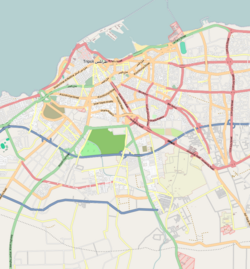| Gurgi Mosque | |
|---|---|
| Arabic: جامع قرجي | |
 The mosque exterior, in 2012 The mosque exterior, in 2012 | |
| Religion | |
| Affiliation | Sunni Islam |
| Ecclesiastical or organisational status | Mosque |
| Status | Active |
| Location | |
| Location | Tripoli, Tripolitania |
| Country | Libya |
 | |
| Geographic coordinates | 32°53′58″N 13°10′32″E / 32.89944°N 13.17556°E / 32.89944; 13.17556 |
| Architecture | |
| Type | Mosque architecture |
| Style | Ottoman |
| Completed | 1834 |
| Specifications | |
| Dome(s) | 15 |
| Minaret(s) | One |
| Minaret height | 25 m (82 ft) |
| Materials | Marble |
The Gurgi Mosque (Arabic: جامع قرجي) is a Sunni Islam mosque, located in Tripoli, Libya. The mosque lies in the heart of old Tripoli (the Medina) as part of a complex of historic buildings. The mosque is an important tourist attraction, as is the area as a whole; nearby is the Roman Arch of Marcus Aurelius.
History
The mosque was commissioned by Mustafa Gurgi and built in 1834. Tripoli then was under Ottoman ruler Pasha Yusuf Karamanli, whose reign extended from 1795 to 1832.The Gurgi Mosque was built by the command of the naval captain Mustafa Gurgi. Gurgi is an Arabic word which means "from Georgia". To the right of the entrance lies the antechamber which houses the tombs of Gurgi and his family. The historic monument mixes European and Islamic geometrics in a way that blends architectural styles from several civilizations in to one statement of art. The Mustafa Gurgi Mosque is located in the Bab al-Bahr district, immediately beside the Mediterranean Sea's coasts. This mosque, like the Ahmed Pasha Karamanli Mosque, is made up of three architectural blocks: the mosque, the tomb, and the school. This mosque has two entrances, one to the west on Al-Akwash Street and the other onto a short alley on the northern side.
Structure
The historic landmark mixes European and Islamic geometrics into a single manifestation of art and beauty, fusing numerous architectural styles from different civilizations. Its walls and columns are adorned with natural marble, and its flooring are covered in multi-colored tiles, creating a wonderfully inspirational and appealing retreat.
The minaret is an essential architectural component of the mosque. It is approximately 25 m (82 ft) tall and has two balconies made of genuine green marble. The mosque's arched entryway are engraved with floral designs, as well as the prayer hall, with its towering marble columns, that provide significant creative results. The Gurgi Mosque is constructed with 15 decorative domes.
Visitors may explore the calligraphy on the walls, which are inscribed with Quranic passages in Andalusian script, as well as a variety of embellishments of geometric forms, plants, and flowers. In the courtyard of the mosque, like in other typical Ottoman-built mosques, there is a mausoleum for the founder, as well as other facilities.
See also
References
- ^ Alharathy, Safa (August 9, 2020). "Gurgi Mosque". The Libya Observer. Retrieved March 13, 2022.
- ^ Al-Ballush, Ali M. (1995). "Preliminary investigations on tile panels in some Libyan religious and secular buildings and on similar tile panels in Tunisia, Algeria and Egypt". Preliminary Investigations on Tile Panels in Some Libyan Religious and Secular Buildings and on Similar Tile Panels in Tunisia, Algeria and Egypt: 135–161.
- Andall, Jacqueline; Duncan, Derek (2010). National Belongings: Hybridity in Italian Colonial and Postcolonial Cultures. Peter Lang. ISBN 978-3-03911-965-3.
- Braun, Ethel (1914). The New Tripoli and what I Saw in the Hinterland. T. Unwin.
- "Ottoman Mosques of the Tripoli Medina by Brian McMorrow". PBase. Retrieved May 16, 2022.
- Miles, Oliver (2009). Wright, John (ed.). "The Emergence of Libya" (Price: £10.00 to Society members.). Libyan Studies. 40. London: Silphium Press: 195–196. doi:10.1017/S0263718900004611. ISBN 978-1-900971-06-5. ISSN 0263-7189. S2CID 163124340.
- Al-Ballush, Ali M. (1995). "Preliminary investigations on tile panels in some Libyan religious and secular buildings and on similartile panels in Tunisia, Algeria and Egypt". Preliminary Investigations on Tile Panels in Some Libyan Religious and Secular Buildings and on Similar Tile Panels in Tunisia, Algeria and Egypt: 135–161.
- Stanienda, K. (2006). "Obiekty geoturystyczne i zabytki kultury materialnej północno-zachodniej Libii". Zeszyty Naukowe. Górnictwo / Politechnika Śląska (in Polish) (z. 273): 367–375. ISSN 0372-9508.
External links
[REDACTED] Media related to Gurgi Mosque at Wikimedia Commons
| Tripoli |
|
|---|---|
| Elsewhere |
|